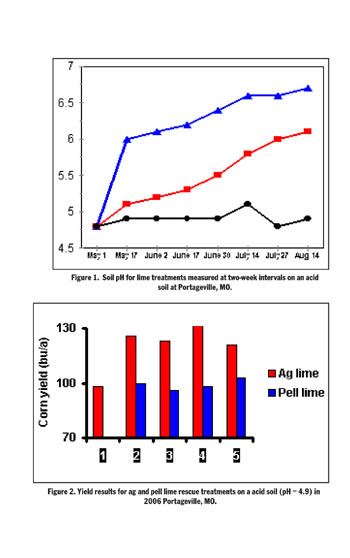Too Late To Lime?
PORTAGEVILLE, MO.
With all the wet weather this spring farmers are behind in field preparations. In the next two weeks corn planting should be well underway, but lime and fertilizers still need to be applied. In order to get everything done producers will have to prioritize field work and budget their time wisely. One of the items I would not skip this year is lime. Anyone who has been to the fertilizer dealership recently knows that N-P-& K are more expensive then ever. Also, as the cost of fuel has gone up, so has the delivered cost of lime. But lime is still a good deal. The lime you apply this year should be active in the soil for the next three years. At $25 per ton and one ton per acre that’s about $8.00 per year. How many bushels of corn does this represent? Of course the amount of lime you need to apply will depend on your soil test. The ideal pH range for corn is 6.0 to 6.5.
One of the questions that I am frequently asked in the soil lab is “Will lime applied this late in the year help this years corn crop?” My answer is that when soil pH is below 4.8 conditions toxic to growing plants exist in the soil and lime will increase yields. If the pH is between 4.8 and 6.0 low pH limits the availability of P and K to the growing plants. At this pH level lime will not increase yields if sufficient P and K are in the soil. At pH levels above 7.0 nutrients like phosphorus, zinc, boron, and copper become less plant available. Lime should not be applied in such situations. Soil testing is the key to your liming decisions.
In a study preformed at the University of Missouri- Delta Center two types of lime were compared to an untreated check. Red and white lime was applied to a pH 4.8 soil at the recommended rate. The lime was then incorporated with tillage and cotton was planted. The pH was checked at two-week intervals. Within two weeks the white lime had increased soil pH to over 6.0. The red lime achieved this level within three months of application. See figure 1. While both types quickly increased the soil pH out of the toxic level the white lime increased the pH more. Cotton lint yields were increased by over 100 lbs./acre for both types of lime. In this study liming just before planting paid for itself the first year.
What about pellatized lime? It is often sold at a steep premium as a quickly acting lime product. Delta Center studies have shown that when pell lime is used at equivalent effective rates as ag lime the effect on soil pH and yields is the same. However a ton of pell lime costs much more than a ton of ag lime. When the same dollar amounts of pell and ag lime were compared, ag lime won hands down. In 2006 several rates of pell and ag lime were compared as a rescue treatment applied post planting to corn growing in 4.9 pH soil. Given an ag lime cost of $25/ton and a pell lime cost of $125/ton both a ton of ag lime and 400 lb of pell lime will cost $25. Comparing these two rates, the ag lime produced 123 bu while the pell lime produced 103 bu.
Full results of this comparison are shown as Figure 2.
This year corn producers will have to make difficult choices. My best advice is to assemble all the information available before making decisions. Lime, if needed, should not be left out of a profitable farming operation. Δ
David Dunn is Supervisor at the Soil Testing Lab at the University of Missouri-Delta Center

Figure 1. Soil pH for lime treatments measured at two-week intervals on an acid soil at Portageville, MO.
Figure 2. Yield results for ag and pell lime rescue treatments on a acid soil (pH = 4.9) in 2006 Portageville, MO.